Inspiring Older Readers
 posted on 24 Mar 2016
posted on 24 Mar 2016
The Library At Night by Alberto Manguel
Every discipline needs it’s public intellectual – someone to articulate their cause and to make the difficult simple. For bibliophiles and book lovers, Alberto Manguel plays that role to absolute perfection. Enthusiastic and avuncular, Manguel is an Argentinean polymath and official citizen of the world who writes so tellingly and enthusiastically about the world of books and reading that even the most reluctant have to succumb.
Manguel, born in 1948 as the son of the Argentine ambassador to Israel, spent an important part of his early adult life in Buenos Aries working in a bookshop frequented by the legendary ( and by then nearly blind) librarian, Jorge Luis Borges and so mixed with the literary circle associated with the great man. A life in literature and books was bound to follow and so it proved – making something of a breakthrough in the UK with his History of Reading.
In The Library At Night Manguel blends the story of the building of his own, personal library in France with the history of libraries in general. Actually, that’s not really accurate in terms of what he’s trying to do – it would be fairer to say that he deconstructs the very idea of the library. In fifteen chapters of varying length he examines the very essence of what libraries have been, are and could be in the future.
We’re left in very little doubt about the kind of library Manguel himself favours because he takes us on a tour of his own creation and explains how he made his own decisions about shelving, how he organises his collection, what’s allowed in and what’s allowed out. Temperamentally he is drawn to the idea of his library at night when the inside lighting reflects the library back in on itself, blanking off the outside world and creating a self-referential cocoon in which he and his books can exist.
It would be a fair to say that Manguel can be a little finicky over detail – how many of us really want a blow by blow account of all the cataloguing options he might adopt to keep track of his books? But it’s excusable because of his evident passion for what he sees as a human institution that is critical to the well-being of the world’s great cultures. For Manguel libraries are indispensible but constantly under assault. He’s quite gloomy about the future of the book - which may reflect the fact that this study was published in 2006 when the perceived wisdom suggested that e-books would takeover and destroy the old technology of printing. In fact, over the intervening decade we have discovered that this was an essential misreading of how things would play out – we now know that electronic and paper books both have a future in providing very different reading experiences.
For me, however, the most entertaining part of the book is Manguel’s undisguised contempt for those librarians who don’t seem to actually like books. Those ‘managers’ who think that microfilm is a good excuse to trash unique volumes because they take up too much room, or, even worse, those who think books should be thrown into a skip if they aren’t borrowed or requested on a regular and frequent basis. In my own experience there are far too many of these people in the library service and I often wonder why they chose this as a profession – they’d clearly be more at home in Tesco.
This isn’t necessarily a book that will appeal to everyone but if you are interested in books, the history of books and the way various world cultures have stored and organised their written heritage, I think it’s one that will keep you entertained.
Terry Potter
March 2016